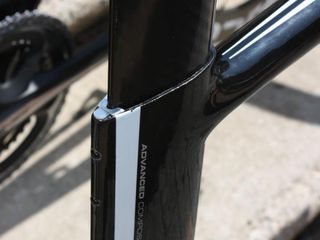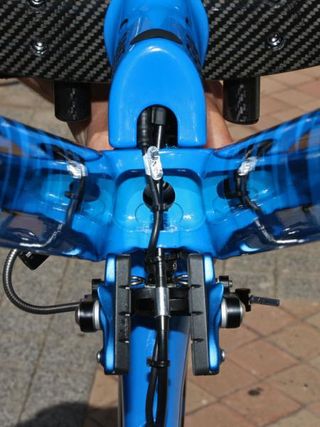It's official – Giant Trinity Advanced SL introduction
Giant's new Trinity Advanced SL to arrive in stores September 2009























As we predicted, Giant officially announced the morning of Stage 4 that it would be offering to the public the same cutting-edge aero bike currently raced by Rabobank in the Tour de France. Save for a few production-friendly refinements, the newly named Trinity Advanced SL is a virtual carbon copy of the team bike with the same aero features, including the innovative front end with its inline stem and top tube, vertical deep-section seat tube, proprietary brake system and clever internal cable routing. Giant estimates consumer versions will be available by early September.
Giant reckons the new Trinity Advanced SL's three frame sizes will accommodate most riders' desired positions thanks to well-spaced stack and reach measurements across the range paired with fairly aggressive 80, 110 and 140mm head tube lengths. Base bar height adjustments on the newly dubbed AeroDrive front end will be a tad more complicated than the norm – requiring users to swap out both the upper and lower carbon fiber stems – but three sets will be included with each bike for a fairly generous total adjustment range of 80mm.
The rest of the proprietary integrated bar is also highly customizable: the extensions can be raised up to 40mm via a series of stacked aluminum spacers; grip widths can be set between 100-180mm (or more depending on how the S-bend extensions are rotated in the clamps); and the system offers about as much extension length adjustment as you dare cut with a hacksaw. The pad width can be set between 220-320mm (outside-to-outside), fore-aft offset can vary up to 15mm and there is five degrees of angular movement built in as well.
The vertically oriented seatpost is surprisingly accommodating, too, with virtual seat tube angles ranging from 74-78 degrees and horizontal saddle offsets from about -8cm to +3cm depending on frame size and seatpost cradle position.

Speaking of the seatpost, the Trinity Advanced SL will trade the conventional integrated seatmast of the road-going TCR Advanced SL for a so-called 'reverse ISP' setup whereby the bottom of the post rests on an internal shelf – instead of cutting the frame, users will need to cut the post. Height adjustments are made by adding or removing spaces and a minimal rear-mounted clamp eliminates any play. Ultimately, though, even if the clamp were completely removed there's no physical way for the seatpost to slip further down into the frame.
The clever internal cable routing will use full housing for all the control lines and differs little from team bikes. Cables are fed inside the base bar and down through the lower stem but instead of popping out of the bottom of the steerer tube as did earlier prototypes, a new forged aluminum fork crown guides the lines straight out the back, just below the mounting bolt for the proprietary rear-mounted scissor brake. The tight confines require the use of an extra-flexible housing such as Nokon – at least until just after the housing enters the down tube – but Giant insists the system runs with very low friction and isn't a nightmare to set up. Access holes are also appropriately sized for Shimano Dura-Ace Di2 and the non-drive chain stay sports an integrated battery mount.

According to Giant, design priorities for the Trinity Advanced SL were aerodynamics first and stiffness second, with weight and aesthetics falling somewhere below. The bike's appearance is decidedly subjective but it's still interesting that Giant offers no official figures for frameset mass, suggesting that it's likely a bit heavier than some of its competition though we're not exactly sure by what margin.
Get The Leadout Newsletter
The latest race content, interviews, features, reviews and expert buying guides, direct to your inbox!
Also of note is the complete absence of frame-mounted bottle bosses – rear-mounted cages or bar-mounted hydration systems only, please.
Giant may have glossed over the Trinity Advanced SL's frame weight but one topic it made sure to emphasize was the pending patent on the AeroDrive front end. The patent abstract describes AeroDrive as follows:
"An aerodynamically configured handlebar assembly for use in a bicycle includes a mounting head which has a rear clamping body for clamping an upper end of a steering stem of a bicycle front fork so as to cantilever a front aerodynamic body of the mounting head, a handlebar body which extends laterally from opposite sides of the front aerodynamic body and which has handgrips at leftmost and rightmost ends thereof, and an aerodynamic bracket member which is disposed beneath the front aerodynamic body and which has a rear crosspiece.
"The crosspiece is secured to a crotch segment of the bicycle front fork by a fastening unit so as to enable the bracket member to better support weight of the cantilevered front aerodynamic body."
The critical term to note here is 'crosspiece', which would seemingly apply to any mechanical means used to attach a front-mounted 'aerodynamic member' to the fork crown area. As such, designs like the Felt DA, Look 596 and Trek's new Speed Concept that use a one-piece fork and external steerer don't fit this description.
Things aren't so clear with Specialized's new S-Works Shiv however, which uses a 'strap' to connect the bottom of its lower stem to the fork crown. Whether or not that bike is in violation of the pending patent (US# 20080036170A1) will be up to the lawyers to decide but Giant – without naming specific models from other makes or potential consequences – firmly states that it "will defend the patent."
This may get interesting.